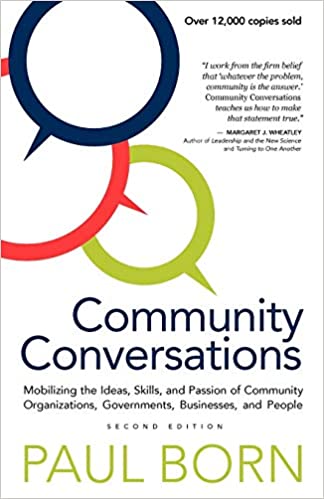Community Conversations

With 20,000 copies sold, Community Conversations is a best-seller.
Community Conversations is an inspiration and a guide to mobilize the ideas, skills and passion of community organizations, governments, business and community members. Full of informative and inspiring examples of collaboration, Community Conversations captures the essence of creating collaborative conversations and offers ten practical techniques for hosting conversations in your community.
Communities around the world are entering a new era of community building. Whether improving economic conditions and reducing poverty, re-energizing citizens and social programs, reducing crime, or revitalizing a troubled neighbourhood, they are engaging people from all sectors as never before to work together as equals to improve their quality of life.
At the heart of this engagement are community conversations, in which common goals are embraced by a diverse array of people with different backgrounds and needs, and influencers are drawn from multiple sectors, including community organizations, the various levels of government, and businesses big and small.
“No one has helped me understand and value the essence of community like Paul Born. Paul has an amazing storytelling ability that excites, challenges, and demystifies and helps us all appreciate the simplicity of moving community from ideal to living reality. This book is a community builder's gem.”
Resources
-
Conversation Cafes are open, hosted conversations in cafés as well as conferences and classrooms—anywhere people gather to make sense of our world. At a Conversation Café there is nothing to join, no homework, no agenda, just a simple process that helps to shift us from small talk to BIG talk, conversations that matter.
-
Future Search is a principle-based PLANNING MEETING that helps people transform their capability for action very quickly. Future Search brings people from all walks of life into the same conversation – those with authority, resources, expertise, information, and need. They meet for 20 hours spread across three days. People tell stories about their past, present, and desired future. Through dialogue they discover their common ground. Only then do they make concrete action plans.
-
Appreciative Inquiry employs a particular way of asking questions and envisioning the future that fosters positive relationships and builds on the basic goodness in a person, a situation, or an organization. In so doing, it tends to enhance a system's capacity for collaboration and change.
-
Open Space Conversations makes it possible to include everybody in constructing agendas and addressing issues that are important to them. Having co-created the agenda and free to follow their passion, people will take responsibility very quickly for solving problems and moving into action. Letting go of central control (i.e., the agenda and assignments) and putting it in the hands of all the participants generates commitment, action, innovation, and follow-through.
-
Photo Voice Photovoice is a process in which people – usually those with limited power due to poverty, language barriers, race, class, ethnicity, gender, culture, or other circumstances – use video and/or photo images to capture aspects of their environment and experiences and share them with others. The pictures can then be used, usually with captions composed by the photographers, to bring the realities of the photographers’ lives home to the public and policy makers and to spur change.
-
Peer input Process is a relatively quick and structured way to get input and insight from peers into a current challenge in your community change effort. It taps into the collective wisdom of peers to gain rapid feedback and new perspectives on a current challenge you are grappling with.
